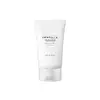What's inside
What's inside
 Key Ingredients
Key Ingredients

 Benefits
Benefits

 Concerns
Concerns

 Ingredients Side-by-side
Ingredients Side-by-side

Water
Skin ConditioningCetearyl Alcohol
EmollientGlyceryl Stearate
EmollientGlycerin
HumectantLactic Acid
BufferingPyrus Malus Fruit Extract
Skin ConditioningIsopropyl Myristate
EmollientCetearyl Phosphate
Skin ConditioningAloe Barbadensis Leaf Juice
Skin ConditioningDictyopteris Polypodioides Extract
EmollientDipotassium Glycyrrhizate
HumectantTetrahexyldecyl Ascorbate
AntioxidantSodium Hyaluronate
HumectantTheobroma Cacao Seed Butter
EmollientCamellia Sinensis Leaf Extract
AntimicrobialButyrospermum Parkii Butter
Skin ConditioningTocopheryl Acetate
AntioxidantCaffeine
Skin ConditioningRetinyl Palmitate
Skin ConditioningTocopherol
AntioxidantCaprylic/Capric Triglyceride
MaskingCaprylyl Glycol
EmollientButylene Glycol
HumectantSodium Polyacrylate
AbsorbentCaprylyl Methicone
Skin ConditioningAmmonium Acryloyldimethyltaurate/Vp Copolymer
Phenoxyethanol
PreservativeEthylhexylglycerin
Skin ConditioningHexylene Glycol
EmulsifyingSodium Hydroxide
BufferingTetrasodium Glutamate Diacetate
Parfum
MaskingWater, Cetearyl Alcohol, Glyceryl Stearate, Glycerin, Lactic Acid, Pyrus Malus Fruit Extract, Isopropyl Myristate, Cetearyl Phosphate, Aloe Barbadensis Leaf Juice, Dictyopteris Polypodioides Extract, Dipotassium Glycyrrhizate, Tetrahexyldecyl Ascorbate, Sodium Hyaluronate, Theobroma Cacao Seed Butter, Camellia Sinensis Leaf Extract, Butyrospermum Parkii Butter, Tocopheryl Acetate, Caffeine, Retinyl Palmitate, Tocopherol, Caprylic/Capric Triglyceride, Caprylyl Glycol, Butylene Glycol, Sodium Polyacrylate, Caprylyl Methicone, Ammonium Acryloyldimethyltaurate/Vp Copolymer, Phenoxyethanol, Ethylhexylglycerin, Hexylene Glycol, Sodium Hydroxide, Tetrasodium Glutamate Diacetate, Parfum
Centella Asiatica Extract 60%
CleansingWater
Skin ConditioningButylene Glycol
HumectantPropanediol
SolventNiacinamide
SmoothingIsotridecyl Isononanoate
EmollientPhenyl Trimethicone
Skin Conditioning1,2-Hexanediol
Skin ConditioningTranexamic Acid
AstringentDiglycerin
HumectantSqualane
EmollientButyrospermum Parkii Butter
Skin ConditioningPolyglyceryl-3 Distearate
EmulsifyingXylitylglucoside
HumectantCetyl Alcohol
EmollientAcrylates/C10-30 Alkyl Acrylate Crosspolymer
Emulsion StabilisingAnhydroxylitol
HumectantPolyacrylate Crosspolymer-6
Emulsion StabilisingArginine
MaskingTrehalose
HumectantZea Mays Starch
AbsorbentXylitol
HumectantPanthenol
Skin ConditioningPentylene Glycol
Skin ConditioningMicrocrystalline Cellulose
AbsorbentMannitol
HumectantGlyceryl Stearate Citrate
EmollientEthylhexylglycerin
Skin ConditioningHydroxyethyl Urea
HumectantGlycerin
HumectantGlucose
HumectantMadecassoside
AntioxidantSodium Hyaluronate
HumectantBisabolol
MaskingHydrogenated Lecithin
EmulsifyingGlyceryl Acrylate/Acrylic Acid Copolymer
HumectantPyrus Communis Flower Extract
Skin ConditioningLactobacillus Ferment
Skin ConditioningCentella Asiatica Extract 60%, Water, Butylene Glycol, Propanediol, Niacinamide, Isotridecyl Isononanoate, Phenyl Trimethicone, 1,2-Hexanediol, Tranexamic Acid, Diglycerin, Squalane, Butyrospermum Parkii Butter, Polyglyceryl-3 Distearate, Xylitylglucoside, Cetyl Alcohol, Acrylates/C10-30 Alkyl Acrylate Crosspolymer, Anhydroxylitol, Polyacrylate Crosspolymer-6, Arginine, Trehalose, Zea Mays Starch, Xylitol, Panthenol, Pentylene Glycol, Microcrystalline Cellulose, Mannitol, Glyceryl Stearate Citrate, Ethylhexylglycerin, Hydroxyethyl Urea, Glycerin, Glucose, Madecassoside, Sodium Hyaluronate, Bisabolol, Hydrogenated Lecithin, Glyceryl Acrylate/Acrylic Acid Copolymer, Pyrus Communis Flower Extract, Lactobacillus Ferment
 Reviews
Reviews

Ingredients Explained
These ingredients are found in both products.
Ingredients higher up in an ingredient list are typically present in a larger amount.
Butylene Glycol (or BG) is used within cosmetic products for a few different reasons:
Overall, Butylene Glycol is a safe and well-rounded ingredient that works well with other ingredients.
Though this ingredient works well with most skin types, some people with sensitive skin may experience a reaction such as allergic rashes, closed comedones, or itchiness.
Learn more about Butylene GlycolThis ingredient is also known as shea butter. It is an effective skin hydrator and emollient.
Emollients help soothe and soften your skin. It does this by creating a protective film on your skin. This barrier helps trap moisture and keeps your skin hydrated. Emollients may be effective at treating dry or itchy skin.
Shea butter is rich in antioxidants. Antioxidants help fight free-radicals, or molecules that may harm the body. It is also full of fatty acids including stearic acid and linoleic acid. These acids help replenish the skin and keep skin moisturized.
While Shea Butter has an SPF rating of about 3-4, it is not a sunscreen replacement.
Shea butter may not be fungal acne safe. We recommend speaking with a professional if you have any concerns.
Learn more about Butyrospermum Parkii ButterEthylhexylglycerin (we can't pronounce this either) is commonly used as a preservative and skin softener. It is derived from glyceryl.
You might see Ethylhexylglycerin often paired with other preservatives such as phenoxyethanol. Ethylhexylglycerin has been found to increase the effectiveness of these other preservatives.
Glycerin is already naturally found in your skin. It helps moisturize and protect your skin.
A study from 2016 found glycerin to be more effective as a humectant than AHAs and hyaluronic acid.
As a humectant, it helps the skin stay hydrated by pulling moisture to your skin. The low molecular weight of glycerin allows it to pull moisture into the deeper layers of your skin.
Hydrated skin improves your skin barrier; Your skin barrier helps protect against irritants and bacteria.
Glycerin has also been found to have antimicrobial and antiviral properties. Due to these properties, glycerin is often used in wound and burn treatments.
In cosmetics, glycerin is usually derived from plants such as soybean or palm. However, it can also be sourced from animals, such as tallow or animal fat.
This ingredient is organic, colorless, odorless, and non-toxic.
Glycerin is the name for this ingredient in American English. British English uses Glycerol/Glycerine.
Learn more about GlycerinSodium Hyaluronate is hyaluronic acid's salt form. It is commonly derived from the sodium salt of hyaluronic acid.
Like hyaluronic acid, it is great at holding water and acts as a humectant. This makes it a great skin hydrating ingredient.
Sodium Hyaluronate is naturally occurring in our bodies and is mostly found in eye fluid and joints.
These are some other common types of Hyaluronic Acid:
Learn more about Sodium HyaluronateWater. It's the most common cosmetic ingredient of all. You'll usually see it at the top of ingredient lists, meaning that it makes up the largest part of the product.
So why is it so popular? Water most often acts as a solvent - this means that it helps dissolve other ingredients into the formulation.
You'll also recognize water as that liquid we all need to stay alive. If you see this, drink a glass of water. Stay hydrated!
Learn more about Water